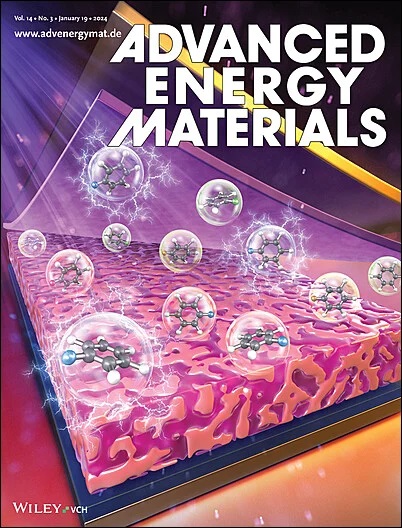Enabling Metal Fluorides Cathodes at Elevated Temperatures Using a Molten Salt Electrolyte
IF 24.4
1区 材料科学
Q1 CHEMISTRY, PHYSICAL
引用次数: 0
Abstract
Conversion-type metal fluorides (MFs) cathodes are promising candidates for high-energy lithium–ion batteries. However, their cycling performance is limited due to the decomposition of organic solvent electrolytes at the cathode/electrolyte interface and the dissolution of active materials during cycling, especially at elevated temperatures (above 60 °C). To address these challenges, a thermally stable, organic solvent-free electrolyte (OSFE) composed of three low melting alkali perfluorinated sulfonimide salts is developed, which helps to minimize the undesirable solvent decomposition. Additionally, chemical vapor deposition technology is employed to apply a conformal carbon coating to a representative MF, NiF2, effectively preventing the dissolution of active materials. The synergistic effect of OSFE and carbon coating enables a previously uncyclable NiF2 cathode, which exhibits a high reversible discharge capacity of 450 mAh g−1 after 160 cycles at 80 °C. Moreover, by incorporating 10 wt.% Li10GeP2S12 (LGPS) into the OSFE, the cycle number of NiF2 is extended to 300 cycles, maintaining an impressive discharge capacity of 350 mAh g−1 at 60 °C. These advancements highlight the potential for successful operation of MFs at elevated temperatures using OSFE, paving the way for their practical applications and future commercialization.

求助全文
约1分钟内获得全文
求助全文
来源期刊

Advanced Energy Materials
CHEMISTRY, PHYSICAL-ENERGY & FUELS
CiteScore
41.90
自引率
4.00%
发文量
889
审稿时长
1.4 months
期刊介绍:
Established in 2011, Advanced Energy Materials is an international, interdisciplinary, English-language journal that focuses on materials used in energy harvesting, conversion, and storage. It is regarded as a top-quality journal alongside Advanced Materials, Advanced Functional Materials, and Small.
With a 2022 Impact Factor of 27.8, Advanced Energy Materials is considered a prime source for the best energy-related research. The journal covers a wide range of topics in energy-related research, including organic and inorganic photovoltaics, batteries and supercapacitors, fuel cells, hydrogen generation and storage, thermoelectrics, water splitting and photocatalysis, solar fuels and thermosolar power, magnetocalorics, and piezoelectronics.
The readership of Advanced Energy Materials includes materials scientists, chemists, physicists, and engineers in both academia and industry. The journal is indexed in various databases and collections, such as Advanced Technologies & Aerospace Database, FIZ Karlsruhe, INSPEC (IET), Science Citation Index Expanded, Technology Collection, and Web of Science, among others.
 求助内容:
求助内容: 应助结果提醒方式:
应助结果提醒方式:


